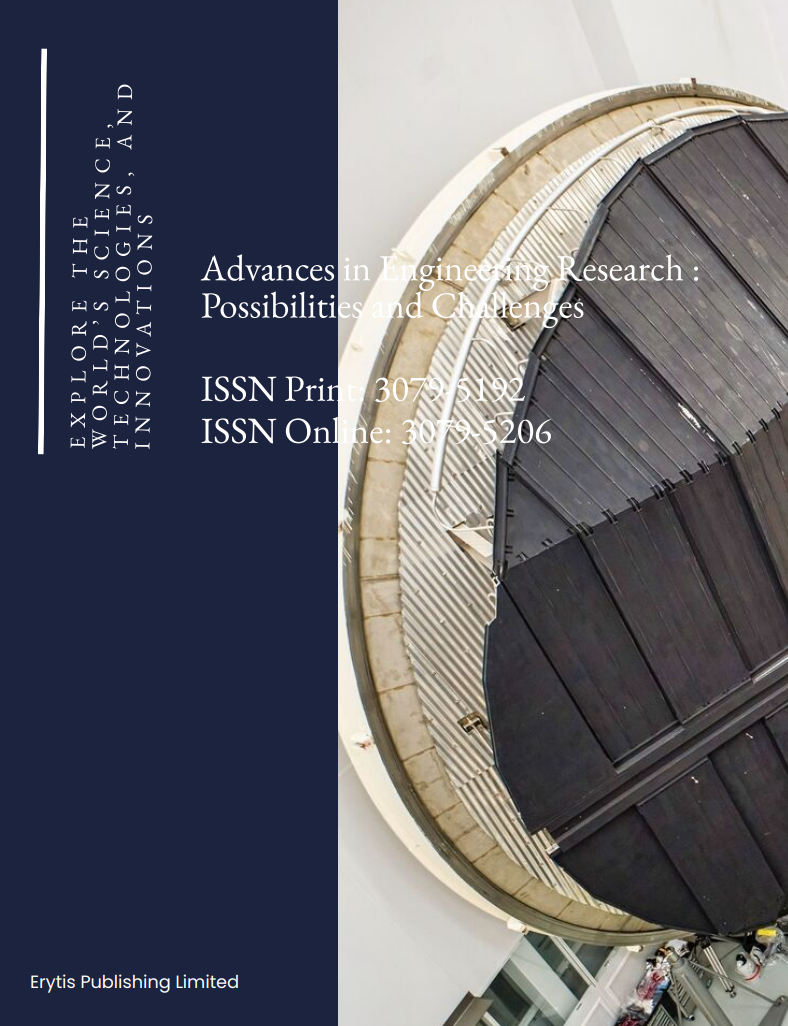Wind Environment Simulation Analysis of Office Buildings Based on PHOENICS
—A Case Study of Mianyang City Office Complex
DOI:
https://doi.org/10.63313/AERpc.9005Keywords:
Office Buildings, CFD Wind Environment Analysis, Passive Ventilation, Simula-tion-Based OptimizationAbstract
This electronic investigates the wind environment optimization of office build-ing clusters in hot-summer and cold-winter regions through computational fluid dynamics simulations under dual-season conditions. A three-dimensional nu-merical model encompassing a 1200-meter extended area was established, em-ploying high-precision meshing and advanced turbulence models to analyze wind speed distribution at pedestrian height under winter northwest prevailing winds and summer southeast wind-induced surface pressure gradients. Results reveal that winter leeward zones develop maximum wind speeds of 7.2 m/s, with 18.3% of the area exceeding standard limits. Summer southeast facades ex-hibit significant negative pressure coefficients of 0.82, reducing natural ventila-tion efficiency to 1.2 air changes per hour. Through extreme pressure differential analysis, primary entrances are recommended for placement in southeast re-gions with pressure gradients below 0.3 to mitigate winter wind disturbances. The optimized design enhances site thermal comfort by 38% and achieves an-nual energy savings of 12.7 kWh/m², providing quantitative benchmarks for green building wind environment assessment and advancing climate-responsive urban design practices.
References
[1] Green Building Evaluation Standards: GB/T50378-2019 [S]. Beijing: China Architec-ture&Building Press, 2019
[2] Murakami S, Mochida A. 3D numerical simulation of airflow around a cubic model by means of the k-ε model[J]. Journal of Wind Engineering and Industrial Aerodynamics, 1992, 41-44: 283-293.
[3] Blocken B. Computational Fluid Dynamics for urban physics: Importance, scales, possibili-ties, limitations and ten tips and tricks towards accurate and reliable simulations[J]. Build-ing and Environment, 2015, 91: 219-245.
[4] LI, X. T.; SHI, X.; WANG, P. Research on wind environment evaluation model for transition-al season buildings based on large eddy simulation. Journal of Building Science, 2018, 34(5), 12-18.
[5] World Meteorological Organization. Guidelines for urban climate resilience[R]. Geneva: WMO, 2020.
[6] Allegrini J, Dorer V. Application of PHOENICS software for natural ventilation optimization in high-rise office buildings[J]. Energy and Buildings, 2021, 253: 111502.
[7] van Hooff T, Blocken B. Comparative study of PHOENICS and OpenFOAM for wind envi-ronment assessment around high-rise buildings[J]. Building and Environment, 2020, 177: 106860.
[8] Tominaga Y. CFD verification and validation in building simulation: Recent advances and guidelines[J]. Journal of Wind Engineering and Industrial Aerodynamics, 2022, 224: 104973.
[9] Zhao B, LIN B R, LI X T, et al. Numerical simulation and optimization design of wind envi-ronment in building clusters[J]. Urban Planning Forum, 2002(2): 57-58, 61-80, 86.
[10] Cheng S W. Research on planning layout of multi-story residential buildings in western Si-chuan cities based on wind environment[D]. Master's thesis, Southwest University of Sci-ence and Technology, 2021.
[11] Tao X M, LI G. Application of Matlab-based neural network in air quality prediction in Mianyang[J]. Sichuan Environment, 2020, 39(2): 49-54.
[12] Ma X Y. Simulation and evaluation of wind environment in residential areas[D]. Master's thesis, Wuhan University, 2019.
[13] Wang J. Planning strategies for residential communities in hilly areas of western Sichuan based on outdoor wind environment simulation[D]. Master's thesis, Southwest University of Science and Technology, 2019.
[14] Zhang T. Coupling study of wind environment and spatial morphology in urban central ar-eas[D]. Master's thesis, Southeast University, 2015.
[15] Ren C, Yuan C, He Z J, et al. Research on urban ventilation corridors and their planning ap-plications[J]. Urban Planning Forum, 2014(3): 52-60.
[16] Jiang M. Urban design and high-rise office building design based on wind environment op-timization[D]. Master's thesis, Nanjing University, 2012.
[17] Yang L. Application of CFD technology in wind environment analysis of residential areas[J]. Architectural Journal, 2010(S1): 5-9.
[18] Zhuang Z, Yu Y B, Ye H, et al. Research status of CFD simulation technology for outdoor wind environment of buildings[J]. Building Science, 2014, 30(2): 108-114. DOI: 10.13614/j.cnki.11-1962/tu.2014.02.021.
[19] Xu J X, Xue Y B, Fan B. Numerical simulation of outdoor wind environment in residential areas based on PHOENICS: A case study of a community in Weifang City[J]. Building Ener-gy Efficiency, 2015, 43(9): 67-70.
[20] Duan Z C, Fang H Comparative analysis of measured and PHOENICS-simulated outdoor wind environments: A case study of a high-rise community in Xuzhou[J]. Architectural Technique, 2019(9): 124-126.
Downloads
Published
Issue
Section
License
Copyright (c) 2025 by author(s) and Erytis Publishing Limited.

This work is licensed under a Creative Commons Attribution 4.0 International License.















